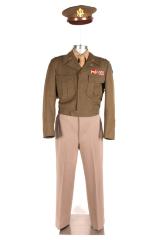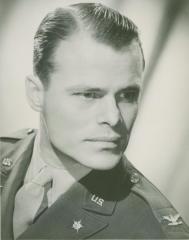Comments and Tags
Be the first to comment on this item!
Clothing Accessories
Clothing and Accessories
Men's Clothing
Headwear
Uniforms
World War II ➔ Military Cap
Identifier:
1995.54.3Description:
This service cap accompanies uniform number 1995.54.2 and is from the United States Army of the United States Armed Forces. It was worn by Army Intelligence Colonel Ralph Hauenstein of Grand Rapids, Michigan while serving in Europe during World War II (1939-1945).This cap is made of olive drab wool and has a leather chinstrap attached by gold buttons. It also has a gold officer's insignia on the center front.
Date:
1941 – 1950Materials:
Wool, LeatherDimensions:
5.25" h 10.5" w 11" dCurrent Location Status:
In StorageCollection Tier:
Tier 2Source:
Gift Of Ralph HauensteinLinks:
http://quanonline.com/military/military_reference/american/wwii_headgear/ww2off.phpRelated Entities:
J. Collett, Ltd. (creator) Ralph Hauenstein (donor)Born March 20, 1912, in Fort Wayne Indiana, Ralph Hauenstein was a resident of the Grand Rapids area since the age of 12. A lifelong friend of Gerald R. Ford, 38th President of the United States, Hauenstein had been a journalist, war hero, entrepreneur, and philanthropist.
Hauenstein joined the U.S. Military in 1935 and, following officer training, became commander of an all-African-American Civilian Conservation Corps camp near Cadillac Michigan. In December 1940, after working for the Grand Rapids Herald as a journalist and then city editor, he returned to active duty as an intelligence officer in Iceland. During the Second World War, Hauenstein rose to the rank of colonel.
As Chief of the Intelligence Branch for the U.S. Army’s European Theater of Operations, he played a key role in the Ultra Project, which worked to decode German signals intelligence. Hauenstein received numerous decorations for his service, including the U.S. Legion of Merit, the French Croix de Guerre (with palm), and the Order of the British Empire. In 1944-45, Hauenstein was among the first Americans into the recently liberated Paris, Germany and Nazi concentration camps, including Dachau. Reflecting on his experiences, the Hauenstein Center quotes him as stating, “In the twentieth century, I saw with my own eyes the worst that leaders are capable of. In the twenty-first century, I want to encourage the best leadership possible so that the world will be better for my children’s children.” Hauenstein continued as an intelligence officer after the war, serving as Deputy Chief of Intelligence for the War Department from 1946-1947. His experiences in the Intelligence Branch are captured in the 2005 book Intelligence was My Line: Inside Eisenhower’s Other Command, as told by Ralph Hauenstein to Donald Markle.
Returning to the United States, Hauenstein worked to link the United States and Europe through trade establishing the Tri-Continental Trading Company in New York City and as the owner of Werner Lehara of Grand Rapids, a food equipment manufacturer that brought Goldfish crackers, Andes mints and other foods to the American consumer.
Alongside his entrepreneurial endeavors, he continues to work in service to the public. He served as a consultant on Eisenhower’s President’s Advisory Commission, served as an auditor at the Second Vatican Council in Rome in the 1960s, and participated in team supervising the first free Russian elections in 1996. One of the most prominent philanthropists in West Michigan, he has served on the board that founded the Van Andel Institute, founded the Hauenstein Center for Presidential Studies at Grand Valley State University, and provided seed money for the Hauenstein Neurosciences Center at Saint Mary’s Health Center.
Ralph Hauenstein (used by)
Born March 20, 1912, in Fort Wayne Indiana, Ralph Hauenstein was a resident of the Grand Rapids area since the age of 12. A lifelong friend of Gerald R. Ford, 38th President of the United States, Hauenstein had been a journalist, war hero, entrepreneur, and philanthropist.
Hauenstein joined the U.S. Military in 1935 and, following officer training, became commander of an all-African-American Civilian Conservation Corps camp near Cadillac Michigan. In December 1940, after working for the Grand Rapids Herald as a journalist and then city editor, he returned to active duty as an intelligence officer in Iceland. During the Second World War, Hauenstein rose to the rank of colonel.
As Chief of the Intelligence Branch for the U.S. Army’s European Theater of Operations, he played a key role in the Ultra Project, which worked to decode German signals intelligence. Hauenstein received numerous decorations for his service, including the U.S. Legion of Merit, the French Croix de Guerre (with palm), and the Order of the British Empire. In 1944-45, Hauenstein was among the first Americans into the recently liberated Paris, Germany and Nazi concentration camps, including Dachau. Reflecting on his experiences, the Hauenstein Center quotes him as stating, “In the twentieth century, I saw with my own eyes the worst that leaders are capable of. In the twenty-first century, I want to encourage the best leadership possible so that the world will be better for my children’s children.” Hauenstein continued as an intelligence officer after the war, serving as Deputy Chief of Intelligence for the War Department from 1946-1947. His experiences in the Intelligence Branch are captured in the 2005 book Intelligence was My Line: Inside Eisenhower’s Other Command, as told by Ralph Hauenstein to Donald Markle.
Returning to the United States, Hauenstein worked to link the United States and Europe through trade establishing the Tri-Continental Trading Company in New York City and as the owner of Werner Lehara of Grand Rapids, a food equipment manufacturer that brought Goldfish crackers, Andes mints and other foods to the American consumer.
Alongside his entrepreneurial endeavors, he continues to work in service to the public. He served as a consultant on Eisenhower’s President’s Advisory Commission, served as an auditor at the Second Vatican Council in Rome in the 1960s, and participated in team supervising the first free Russian elections in 1996. One of the most prominent philanthropists in West Michigan, he has served on the board that founded the Van Andel Institute, founded the Hauenstein Center for Presidential Studies at Grand Valley State University, and provided seed money for the Hauenstein Neurosciences Center at Saint Mary’s Health Center.
United States Army (is related to)
The United States Army is a service branch of the United States Armed Forces that specializes in ground-based offensive and defensive warfare. The mission of the United States Army is to fight and win our Nation's wars, by providing prompt, sustained, land dominance, across the full range of military operations and the spectrum of conflict, in support of combatant commanders.The United States Army we know today has roots that can be traced back to the Continental Army which was formed in 1775 during the American Revolutionary War. After the War, The Congress of the Confederation officially created the United States Army in 1784 to replace the disbanded Continental Army. The United States Army is the largest military branch of the armed forces in which participates in disputes worldwide today through preserving peace and security and providing for the defense of the United States.


